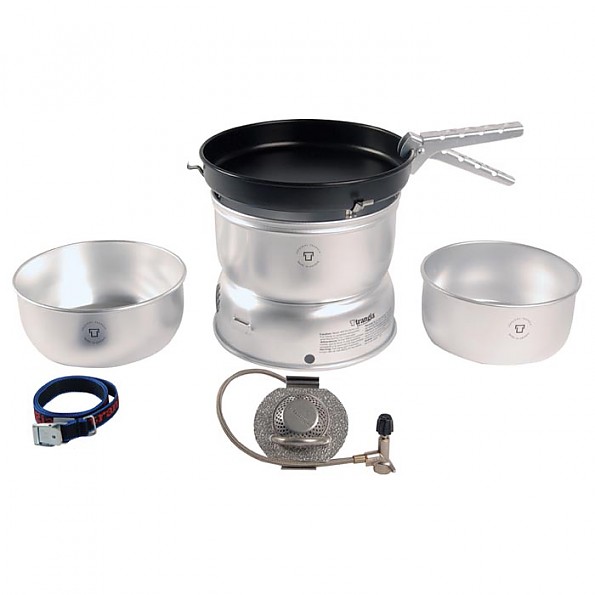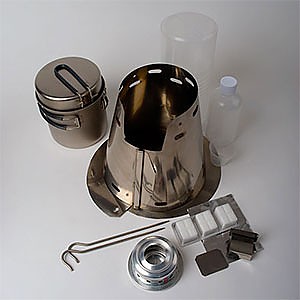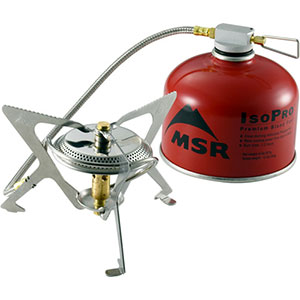Compressed Fuel Canister Stoves
Canister stoves burn compressed gas sold in a pressurized container that screws onto the burner. Some models feature an integrated pot. Due to their reasonably light weight and ease of use, canister stoves are the most popular and widespread type of stove for backpacking. They are best for three-season trips where you have access to fuel canisters that are compatible with your stove.
On This Page
Top Picks
How we choose: The best compressed fuel canister stoves highlighted here were selected based on 689 reviews of 132 products. Our top picks are those that are readily-available in the United States and have received the highest overall ratings from reviewers.
How we test: Trailspace is powered entirely by our community of readers. The reviews posted here reflect the real-world experiences of outdoor enthusiasts just like you.
If you've used a compressed fuel canister stove that you think should be listed here, please share your experience.
Disclosure: Trailspace never accepts payment for gear reviews, product placement, or editorial coverage. When you buy through affiliate links on our site, Trailspace may earn a small commission, which helps cover the costs of running the site.
MSR PocketRocket 2
A good redesign of a classic. For those who like the ease, speed, and the versatility of a compressed fuel canister stove to boil and simmer, the MSR PocketRocket 2 is a great choice. It’s very easy to use and very reliable. It’s more compact and sturdier than its predecessors, and fairly lightweight, especially without the case. Any cons associated with a PocketRocket2 involve gas canisters and not the stove. If you use a canister, I recommend this stove.
Reasons to Buy
- Lightweight
- Very easy to use
- Sturdy
- Low/no maintenance
- Quick boil
- Very compact
Reasons to Avoid
- No built-in igniter
- Gas canister fuel levels are hard to gauge
- Gas canisters are bulky and heavy
- Gas canisters don't work well in cold weather
The MSR PocketRocket 2 (PR2) is the latest generation of canister stove from MSR. It replaces both the original PocketRocket (PR1) and the MicroRocket, which are now discontinued (though the original PocketRocket is available for purchase in the MSR PocketRocket Stove Kit), and combines the best elements of both. It is more similar in design and specifications to the MicroRocket, though after extensive use of all three, performance differences are negligible. MSR’s write up: The next-generation PocketRocket™ 2 stove takes everything impressive about the iconic original and puts it into an even smaller and lighter high-performance design.
Read more: MSR PocketRocket 2 review (1)
Primus Essential Trail Kit
The Primus Essential Trail Kit is an inexpensive, lightweight, and versatile stove kit from a renowned manufacturer.
Reasons to Buy
- Lightweight
- Packs small
- Quality build
- Exceptional design
Reasons to Avoid
- No built-In igniter
- Handles can get hot
- QC—scrape in ceramic coating
- Can require shielding from wind
I received this Primus Essential Trail Kit in the winter of 2020-2021 for the purpose of reviewing it. Winter weather, Covid, and major surgery have all done their best to keep me indoors, but I have managed to sneak out on a few occasions. So without further ado…. Primus is a Swedish company known for producing top quality stoves since 1892 (!). They balance out carbon emissions from the use of their fuel by helping reduce emissions elsewhere, claiming the industry’s only carbon neutral fuel canisters.
Read more: Primus Essential Trail Kit review (1)
Jetboil MightyMo
The MightyMo is a compact canister stove that will not disappoint! With features like a piezo-style ignition and a simmer control that idles lower than ever, this efficient burner is ideal for many styles of campers and backpackers. Ultra-light hikers and backcountry chefs will both find this little piece of gear part of their everyday carry!
Reasons to Buy
- Easy to operate
- Lightweight (95g/3.4oz)
- Built-in ignition
- Additional surface area for pot
Reasons to Avoid
- Canister-style stove systems are inherently heavier
SPECS Output: 10,000 BTU Fuel Type: Isobutane Propane Ignition: Built-In Piezo Igniter Dimensions- 4"x6" (folded for storage) Weight- 95g/3.4oz Included Fuel Can Stabilizer Included Cloth Storage Bag Setting up the kitchen in Monongahela NF, West Virginia Jetboil has been a household name in the outdoor industry for a while now, selling their all-in-one style canister stoves. The company has recently broken the mold, releasing the compact MightyMo. Looking briefly at the burner, the MightyMo could easily be mistaken as the venerable MSR PocketRocket.
Read more: Jetboil MightyMo reviews (3)
MSR WhisperLite Universal
Finally here is a true multi-fuel (MSR calls it a hybrid) stove that burns both liquid fuels and canister gas (upright or inverted). Not only does it burn these fuels, but it does it well — plus it simmers...no it really does! In just a couple minutes the stove can be configured to burn the various fuels (see below) by simply changing a couple parts using the supplied tool. This is a great option for anyone who wants a stove that can be used year round in multiple climates, with multiple fuels. For groups it allows flexibility through the use of multiple fuels — or for those who travel abroad to places where some fuels may be harder to get or if it's not clear what fuels will be available. The Universal will burn: White gas – Unleaded auto gas – Kerosene Canister gas – (upright or inverted)
Reasons to Buy
- Multi-fuel (liquid and canister)
- Everything is included
- Changing fuel types is quick
- Well built / sturdy
- Will handle large pots
- Good windscreen
- Simmers well
- Instructions easy to understand / follow
Reasons to Avoid
- Price point
- Weight
- Small parts to keep up with
- Will not support pots smaller than 4 ¼ in. or 11 cm. in diameter.
- Fuel line is stiff
A review of the MSR Whisperlite Universal Hybrid fuel stove A backpacking stove made by Cascade Designs – Seattle WA, USA I received this stove from Cascade Designs for testing and used it on five separate outings as well as a lot of testing at home. Stove Description: The stove arrived in a nice looking cardboard package (see photos), it included the stove, all parts for changing fuel types, pressure pump for liquid fuel bottles, canister stand, wind screen and ground protector, a nice stuff sack, and full instructions in three languages (three separate booklets) plus a quick reference guide in two languages, along with warnings etc.
Read more: MSR WhisperLite Universal reviews (12)
Snow Peak GigaPower Manual
The GigaPower 2.0 Stove is a 3-inch stove that's light durable and easy to use! It gives a big flame for a small stove and works with many types of propane brands.
Reasons to Buy
- Small
- Cooks well
- Durable
- Easy to use
Reasons to Avoid
- Doesn't work well when cold
The GigaPower 2.0 stove works great and works well constantly. The stove can easily twist off and on. To light all you have to do is twist the handle and light it with a match or something like that. And it also fits into a 3.5 x 1.5 x 2 inch box. It is well made, so that it can't break or burn itself. I've had it for a few years and it hasn't changed. It works just as well as when I got it. I have used this stove on many winter campouts and sometimes it takes a little bit of time to get it started, but in the summer it lights very fast.
Read more: Snow Peak GigaPower Manual reviews (12)
Jetboil MicroMo Cooking System
The MicroMo is the latest in Jetboil’s impressive line-up of personal cooking systems for backcountry use. Conceptually, the MicroMo attempts to provide a compact, low weight solution, without compromising either quality, features, or performance, which includes the much lauded ability to simmer; in my opinion, it succeeds.
Reasons to Buy
- Compact
- Low weight
- High performance (rapid boil, low fuel use)
- Can simmer, great for cooking
- Excellent construction
- Competitively priced
Reasons to Avoid
- Performance drops off dramatically when not using proprietary Jetboil pot
The MicroMo is the latest in Jetboil’s impressive line-up of personal cooking systems for backcountry use. Conceptually, the MicroMo attempts to provide a compact, low weight solution, without compromising either quality, features, or performance. Below are the currently listed specifications found on the manufacturer's website. In addition to the MicroMo system, I also received the Coffee Press, and the Pot Support for testing. They will be discussed within the overall context of the cooking system.
Read more: Jetboil MicroMo Cooking System reviews (4)
Soto WindMaster
The SOTO WindMaster is a very lightweight stove top that screws onto gas canisters having the industry standard threaded coupling. In my tests, it performed very well in a range of windy conditions, on cool mornings, and with an intentionally chilled half-full fuel canister. It also works well for simmering and "gourmet-style" meals. I recommend it for use by backpackers and others aiming for light weights for solo and 2-person outings. It is not suitable for large groups (4 or more).
Reasons to Buy
- Lightweight and compact
- Burner has “crown” which provides improved wind resistance without a separate wind screen
- Pressure regulator maintains a fairly constant flame throughout most of a canister’s life
- Easy-lighting piezo igniter
- Simmers well and controllably
- Boil times are good for a light, compact canister stove
Reasons to Avoid
- Stove does not come with a canister base support, hence unstable for large pots, especially with the smallest size canisters, and company does not offer one (other brand versions for canisters are available, however).
- Per the printed Cautions and Warnings, stove is limited to pots less than 5 ½ inches in diameter (7 inches with optional 4-prong pot support)
Warranty: No warranty listed in instruction sheet or on website Update: I spent the weekend going in to Carson Pass, intending to go to Round Top Lake. For various reasons (see my trip report) I ended up at Frog Lake. No matter - I had the SOTO Windmaster to use for several meals and melting snow. See the update addendum "Cold Weather Test" below Note: Because of the extended warm spell, mostly under clear, warm, but often windy skies, the tests results do not include cold weather or in-snow testing (80° days in Feb and Mar?!?!!).
Read more: Soto WindMaster reviews (4)
Snow Peak GigaPower Auto
If you're think you're too old-school to go with a canister stove, put your scruples aside. I finally gave my Svea a break and started packing this lightweight, hassle-free babydoll of a stove.
Reasons to Buy
- Lightweight
- Very easy to use
- Compact
- Fast
- Well-constructed
- Efficient
Reasons to Avoid
- Well, you do need canisters.
For both sentimental and financial reasons, I like to use the trusty backpacking equipment that I bought in the mid-1970s. Amazingly, nearly all of my equipment from back then is still serviceable. But it's not all ultralight, nor is it hassle-free. Take my Svea 123 stove, for example. I bought it in 1975, but its design dates back long before that. This stove even has its own Wikipedia page. I'm pretty sure it's the stove that will eventually get me through the Apocalypse. The Svea is a thing of beauty—bright, shiny brass when polished up, it's even cooler looking when it's covered with soot after a week of trail duty.
Read more: Snow Peak GigaPower Auto reviews (44)
Soto Amicus with Igniter
High-quality, compact canister stove for camping and backpacking from Japanese masters Soto. Very efficient and economical, built to last and can simmer, too.
Reasons to Buy
- High quality
- Compact
- Lightweight
- Can simmer
- Large diameter burner
- Integrated, foldable, solid arms
- Efficient
- Relatively silent
- Internal running igniter
- Igniter is convenient
- Inexpensive for the quality
Reasons to Avoid
- Carrying bag not impressive
- Not really windproof
I chose the Amicus over the “king” Windmaster because it has a functional, 4-arm integrated foldable support that won’t get lost or forgotten—ever. It has the same assuring built, minus some features that impact very little real-world functionality. Just holding it in my hand I can feel this thing will perform every time and last for a while, even with little maintenance or care. It’s also lightweight and small, and a joy to use. This has been the case for the months I’ve been using the Amicus indeed. The arms have springs and lock in place by way of small hooks attached to the burner head (see photo).
Read more: Soto Amicus with Igniter reviews (3)
Primus Classic Trail
A great, cheap, no-frills, somewhat lightweight stove.
Reasons to Buy
- Reliability
- Cost
- Ability to simmer
Reasons to Avoid
- Weight
- Fuel efficiency
I went backpacking just this past weekend and found myself in a predicament; the Solo Stove I had planned to use was out of the question as I would be traveling into an area under an open fire ban. And so, I found myself needing to get a cheap, simple to use stove for the weekend. The Primus Classic Trail fit that bill to a tee. With a 225g canister, both items came in at under $30, and worked perfectly with my Solo Pot 900. The pot wasn't quite large enough to store both the canister AND the stove, so it's clearly not a stove for the gram-weenies of the world, but on the trip I was on where weight wasn't an enormous concern, it was just fine. Design-wise the stove is pretty much fool-proof.
Read more: Primus Classic Trail reviews (12)
More Reviews of Compressed Fuel Canister Stoves
Trailspace reviewers have shared 689 reviews of 132 different compressed fuel canister stoves.
or add yours
All about canister stoves
What are the advantages of a canister stove for backpacking?
- light
- compact
- boils water fast
- easy to light, no priming needed
- easy to use
- work well in the wind
What are the downsides?
- not good in the cold, though an inverted canister helps with pressure
- can only use a compatible fuel canister, which can be an issue if traveling
- can't tell easily how much fuel is in canister
- can't refill the fuel canister, though canisters can be recycled
- fuel is more expensive than liquid fuel
- can be affected by altitude
What fuels do they use?
Canister stoves burn a pressurized blend of liquefied petroleum gasses (LPG). Most typically:
- Isobutane: most popular option for backpacking stoves.
- Propane: high vapor pressure; works well in cold weather; heavier canisters
- Butane: cheapest and worst performance
Different stoves may require different fuels / canisters. Propane, for instance, is sold in heavier canisters than isobutane, which also feature a different valve. For this reason, propane and isobutane stoves are typically not cross-compatible.
What is an integrated canister stove?
An integrated canister stove is one in which the burner mates with a stove-specific pot. These designs typically provide increased performance and convenience, but are often less flexible for using other cookware.
Other Types of Backpacking and Camp Stoves
Find more backpacking and camp stoves reviewed in these related categories:

Alcohol Stoves

Liquid Fuel Stoves

Multi-Fuel Stoves

+6 more types
Review Your Outdoor Gear
If you've found this site helpful — or if we've missed something important — please consider paying it forward by some of your favorite outdoor gear.
Why? From professional gearheads to outdoor novices, everyone has an important point of view to contribute. will support the outdoor community and help others find the best gear.
Trailspace reviewers are outdoor enthusiasts like you: hikers, climbers, paddlers, backcountry skiers, and trail runners who share our experiences with the gear and clothing we rely on to get outside. Learn more about Trailspace



